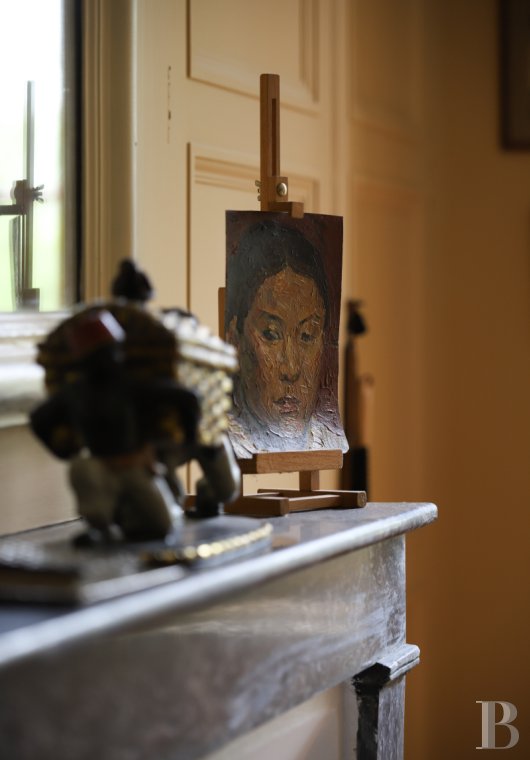Add to favorites
Log in to your personal space

Hidden behind trees, the house is not at all imposing. It is beautiful in its simplicity. Its classic silhouette and the large symmetrical windows that open up the facade to the light make it feel peaceful and welcoming. The 19th century, when it was constructed, gave it its best assets: carefully ordered spaces decorated with wood panelling for elegance, parquet floors for comfort and warmth, light and spacious rooms. That alone might be enough to make it attractive, but the moat along its rear facade, bordered by a stone balustrade bestows it with even more charm. A remnant of the former manor house, it is an invitation to a romantic reverie that perfectly matches the house’s atmosphere. And it is a delightful place to spend a weekend or longer.
As interior designers in Paris, we wanted to set up our agency closer to the sea, and were looking for a home that would suit us. We had an elegant little manor house in mind. Normandy, and in particular the Pays d'Auge, has always appealed to us, with its highly protected land and soothing landscapes. The house also brought us closer to our children, who live in Bessin. It was also the chance to have a real family home, which is what it has become. When we discovered it for the first time, all of us, young and old, fell in love with the house hidden behind its hedges, protected by its moat, which appeared at the end of the long bridle path lined with lime trees and covered in flowers.

This residence is the successor to the former 15th-century manor house of Brocottes, which was probably destroyed at the end of the 18th century. It was at the very beginning of the 19th century, under the reign of Charles X, that the current chateau was rebuilt on the site of the old timber-framed manor house destroyed during the Revolution. Only the moat and outbuildings dating from the end of the 15th century have been preserved. It is a small, very classical chateau built of dressed stone, with a central pediment and rooms arranged symmetrically on either side of the stairwell. We have preserved this pretty neoclassical residence's typically Balzac-style decor and spirit, as well as the integrity of its period character: original espagnolette windows and glazing, elm-wood staircase, panelled woodwork, fireplaces, mirrors, parquet flooring and Caen stone flooring.
Owned by Philippe de la Rivière at the end of the 15th century, the seigneury known as the "Manoir de l'Epinay" was sold under the reign of Charles IX to the de Courseulles family, who sold it at the very beginning of the reign of Louis XV to Lord Jacques Charles Alexandre de Beaurepaire de Louvagny, whose family retained the seigneury of Brocottes for over a century. The family always gave their second-born children the title of "Chevalier de l'Espiney", and it was one of them who saved Queen Marie-Antoinette's life during the October 1789 riots in Versailles by preventing rioters from entering her bedroom until she could get to King Louis XVI in his apartments. After that, only two families succeeded each other before we became the lucky owners. On one of his countless walks through the Auge region, Marcel Proust is said to have had the idea of combining the name of the philosopher Bergson with that of the little village of Brocottes to forge the name Bergotte, "the man with the goatee and the gentle white-haired singer" who forever embodies the character of the famous writer in "In Search of Lost Time".

A traditional welcome in a beautiful house that has retained all its charm and is above all a family home. While the creature comforts are resolutely modern, everything here, from the furniture to the decor, is original. Incomparable tranquillity, surrounded by peaceful nature, silence, flowers, birds, the discreet, wonderful presence of wild animals, roe deer, pheasants, foxes, hares, not to mention the storks nesting in the marshes of the Dives, beautiful walks or bike rides, the Normandy light. To preserve this spirit, we have chosen to only open up two beautiful bedrooms and their en suite bathrooms, each overlooking the lawn and bridle path. For families, two additional, smaller rooms with a double bed and en-suite shower room and a single bed attached to one of the suites are available. Depending on the season, breakfast is served in the dining room in front of the large stone fireplace or in the garden.

In Beuvron, there is “Le Pavé d'Auge”, a gourmet restaurant, and the “Café Forges” with food cooked on a wood fire. “Le Beau Site" seaside restaurant in Cabourg. "La Maison des Coquillages" in Houlgate or, a little further inland, "Le Ptit Normand" in Cambremer. The Cider Route, which passes through Beuvron-en-Auge, one of the "most beautiful villages in France". The Dives marshes, an area of ecological interest covering 10 000 hectares, with walks along the canals, swans, storks and a whole host of protected species. Beaumont-en-Auge, a typical Norman village with exceptional views over the Touques valley. The park and gardens of Château de Canon, Dives-sur-mer and its Saturday morning market, Cabourg filled with memories of Marcel Proust and the races at its racecourse.
240 € - 350 € per night
The house has a guest bedroom with an en-suite shower room, as well as two large suites measuring around 35 m2 each, with an en-suite shower room and dressing room. One of the suites has an adjoining study with a single bed. The enclosed garden, lounge and dining room with fireplace are available to guests. Because of the moat, which is shallow, but accessible in several places, we do not accept children under the age of ten
ref 888168

 A link to enter a new password has been sent to you by email.
A link to enter a new password has been sent to you by email.
By continuing your navigation, you accept the use of cookies to offer you services and offers adapted to your centers of interest and to measure the frequentation of our services. Learn more